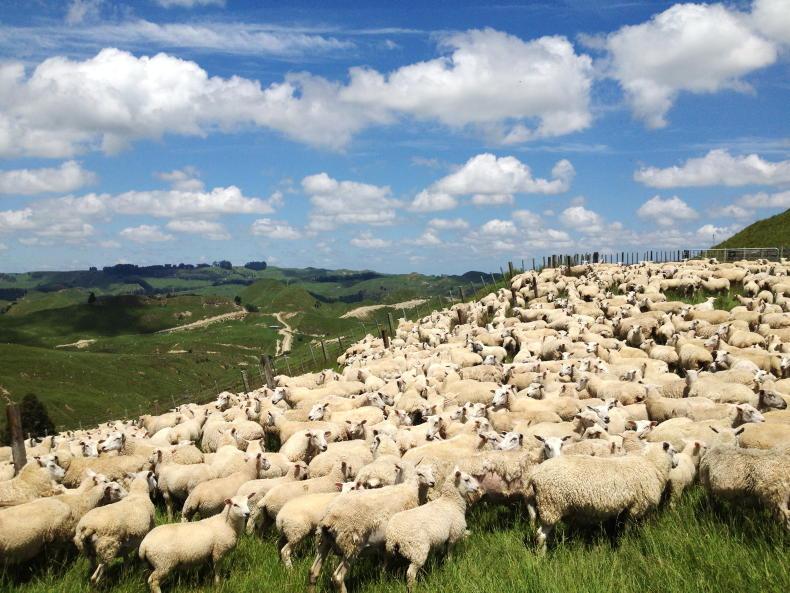Just 30,706t of New Zealand (NZ) mutton and lamb has been exported to the UK market in the nine months to the end of September 2020, figures from HMRC confirm.
It is the lowest figure ever recorded by HRMC and while the dataset only goes back to 2013, it is understood that prior to that, equivalent figures were frequently in excess of 60,000t.
The total to September 2020 is less than half of that sent in the same period in 2013.
NZ exports to the UK have been in steady decline since 2016, partly on the back of a smaller sheep flock, as more farmers moved into dairy.
Focus
But the focus for New Zealand has also switched to supplying the ever-growing Chinese market and for the year to October 2020, China took 47% of all NZ sheep exports.
Over the same period, the EU accounted for 28% of NZ exports, having previously been the main market destination for its product.
As a result, it means that NZ will again not come close to filling its tariff-free EU quota of 228,254t.
To the end of September 2020, it had only imported around 81,000t to the UK and the remaining 27 EU member states combined.
Strong domestic market
With some major UK retailers such as Waitrose and the Co-op committed to stocking 100% British lamb, and with less competition from NZ, it has helped to create a strong UK domestic market in 2020.
If other retailers follow suit, the challenge for the industry is how it can flatten out what is normally a seasonal supply.
At peak season, the UK depends on exports to keep supply and demand in balance, and fills the gap out of season with imports, traditionally from NZ.
In 2020, the UK’s main export destination has remained France, followed by Germany and the Republic of Ireland (ROI).
To September 2020, exports to ROI stood at 8,392t, which is nearly double the trade in the other direction.
With EU data on the trade in sheep now based on 27 member states, NZ is no longer the biggest importer of sheep meat to the EU27. The UK now tops that list.
Read more
‘Dog attacks can lead to devastation for farmers’
Looking at the pros and cons of winter shearing
Just 30,706t of New Zealand (NZ) mutton and lamb has been exported to the UK market in the nine months to the end of September 2020, figures from HMRC confirm.
It is the lowest figure ever recorded by HRMC and while the dataset only goes back to 2013, it is understood that prior to that, equivalent figures were frequently in excess of 60,000t.
The total to September 2020 is less than half of that sent in the same period in 2013.
NZ exports to the UK have been in steady decline since 2016, partly on the back of a smaller sheep flock, as more farmers moved into dairy.
Focus
But the focus for New Zealand has also switched to supplying the ever-growing Chinese market and for the year to October 2020, China took 47% of all NZ sheep exports.
Over the same period, the EU accounted for 28% of NZ exports, having previously been the main market destination for its product.
As a result, it means that NZ will again not come close to filling its tariff-free EU quota of 228,254t.
To the end of September 2020, it had only imported around 81,000t to the UK and the remaining 27 EU member states combined.
Strong domestic market
With some major UK retailers such as Waitrose and the Co-op committed to stocking 100% British lamb, and with less competition from NZ, it has helped to create a strong UK domestic market in 2020.
If other retailers follow suit, the challenge for the industry is how it can flatten out what is normally a seasonal supply.
At peak season, the UK depends on exports to keep supply and demand in balance, and fills the gap out of season with imports, traditionally from NZ.
In 2020, the UK’s main export destination has remained France, followed by Germany and the Republic of Ireland (ROI).
To September 2020, exports to ROI stood at 8,392t, which is nearly double the trade in the other direction.
With EU data on the trade in sheep now based on 27 member states, NZ is no longer the biggest importer of sheep meat to the EU27. The UK now tops that list.
Read more
‘Dog attacks can lead to devastation for farmers’
Looking at the pros and cons of winter shearing







 This is a subscriber-only article
This is a subscriber-only article










SHARING OPTIONS: